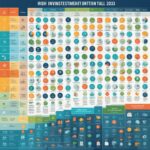When it comes to investing, finding the right balance between risk and return is crucial. While high-risk investments may offer the potential for high returns, they also come with a greater chance of loss. In uncertain economic times, it’s wise to consider low-risk investments that can provide stable returns and help secure your financial future.
Low-risk investments are ideal for conservative investors who prioritize capital preservation and steady income. These investments may not offer the same level of returns as riskier options, but they provide a measure of security and peace of mind. Whether you are a seasoned investor or just starting out, it’s essential to explore the best low-risk investments available in 2024.
In this article, I will introduce you to the 11 best low-risk investments with the potential for high returns in 2024. We will discuss various investment vehicles, strategies, and products that can help you build a strong and secure investment portfolio. By diversifying your investments across these low-risk options, you can mitigate risk while still aiming for attractive returns.
Key Takeaways:
- Low-risk investments are essential for conservative investors seeking stable returns.
- These investments prioritize capital preservation and income generation.
- By diversifying across various low-risk options, you can mitigate risk.
- Consider your risk tolerance and long-term goals when choosing low-risk investments.
- Regularly review and adjust your portfolio to ensure it aligns with your objectives.
The Importance of Low-Risk Investments in a Volatile Market
In today’s volatile market, where economic conditions can quickly shift, it is crucial to prioritize low-risk investments to safeguard your financial stability. Low-risk investments offer a reliable means to minimize potential losses and provide much-needed stability to your investment portfolio. By considering your risk tolerance and long-term goals, you can identify low-risk investment options that align perfectly with your personal financial objectives.
When faced with a volatile market, the primary concern is often the preservation of capital and the mitigation of potential losses. Low-risk investments help achieve this objective by minimizing exposure to unpredictable market fluctuations. These investments prioritize stability and consistency over high returns, providing a cushion to weather the storm during periods of market volatility.
Assessing your risk tolerance is an essential step in identifying suitable low-risk investments. Every investor has a unique risk appetite, and it’s vital to invest in assets that match your comfort level. Low-risk investments offer a more conservative approach, making them an ideal choice for investors who prioritize preserving their wealth rather than seeking aggressive growth.
Moreover, it’s essential to align your low-risk investments with your long-term goals. Whether you’re saving for retirement, funding your child’s education, or planning for a major purchase, low-risk investments can offer a reliable path to achieving these objectives. Their steady and predictable performance can provide a sense of security and assurance, enabling you to plan for the future with confidence.
“In a volatile market, low-risk investments can help mitigate potential losses and provide stability to your investment portfolio.”
When selecting low-risk investments, it’s crucial to understand the trade-off between risk and return. Low-risk investments typically offer lower potential returns compared to riskier assets. However, these investments provide a level of certainty and consistency that can be invaluable in an unpredictable market. By establishing a balanced investment approach that includes low-risk assets, you can achieve a sense of financial stability while still achieving your long-term goals.
Investing in low-risk assets allows you to navigate the ups and downs of market volatility while maintaining a stable and reliable investment portfolio. By diversifying your investments and incorporating low-risk strategies, you can protect your wealth and stay on track to achieve your financial aspirations.
Factors to Consider When Choosing Low-Risk Investments
When it comes to low-risk investments, there are several factors that you should carefully consider. By evaluating these factors, you can make informed decisions that align with your financial goals and risk appetite.
1. Risk Exposure: Assessing Your Tolerance for Risk
Low risk investments are designed to minimize the potential for loss. However, it’s important to determine your personal risk exposure and how much risk you are willing to take. Ask yourself:
- What is my comfort level with volatility in my investments?
- Am I willing to accept a lower level of potential return in exchange for greater stability?
- How would potential losses impact my overall financial situation?
Understanding your risk tolerance will help guide you in choosing low-risk investments that match your comfort level.
2. Potential Returns: Balancing Stability and Growth
While low-risk investments may provide protection against significant losses, it’s important to consider the potential returns they offer. Keep in mind that low-risk investments typically yield lower returns compared to higher-risk investments. However, you should evaluate the balance between stability and growth that aligns with your financial goals. Ask yourself:
- What is the expected rate of return of the investment?
- Does the potential return align with my long-term financial objectives?
- Am I comfortable with the trade-off between lower returns and greater stability?
Evaluating potential returns will help you make choices that are in line with your desired financial outcomes.
3. Inflation: Protecting Your Purchasing Power
Inflation can have a substantial impact on the purchasing power of your money over time. When considering low-risk investments, it’s crucial to assess the impact of inflation on your investment returns. Ask yourself:
- How will inflation affect the purchasing power of my investment over time?
- Is the potential return of the investment sufficient to counteract the effects of inflation?
- Are there alternative low-risk investments that offer better protection against inflation?
By factoring in inflation, you can choose investments that preserve and grow your wealth in real terms.
4. Risk Appetite: Aligning Investments with Your Comfort Level
Another essential consideration when choosing low-risk investments is your risk appetite. Every individual has a different level of comfort when it comes to taking risks. Ask yourself:
- Am I conservative or willing to be more aggressive in my investment approach?
- Do I prefer investments with minimal or near-zero risk?
- Am I open to slightly higher risk if it offers the potential for higher returns?
Understanding your risk appetite will guide you in selecting low-risk investments that align with your comfort level.
By considering these factors – risk exposure, potential returns, inflation, and risk appetite – you can make well-informed decisions when choosing low-risk investments. Remember, finding the right balance between risk and reward is crucial to achieving your financial goals.
High-Yield Savings Accounts
When it comes to low-risk investments, high-yield savings accounts are a top choice for conservative investors. These accounts not only offer a safe place to keep your money, but they also provide a modest return on your investment. With their combination of security and liquidity, high-yield savings accounts are an attractive option for those who prioritize capital preservation.
One key advantage of high-yield savings accounts is that they are FDIC-insured. The Federal Deposit Insurance Corporation (FDIC) insures deposits up to $250,000 per depositor, per insured institution. This means that even if the financial institution fails, your investment is protected.
While the returns on high-yield savings accounts may be lower compared to other investments, the trade-off is the low level of risk involved. These accounts are designed to provide stability and are suitable for individuals who prioritize the preservation of their capital over high returns.
It’s important to note that high-yield savings accounts are not subject to market fluctuations, making them ideal for risk-averse investors. Additionally, they offer easy access to your funds, allowing you to withdraw or transfer money whenever needed.
Benefits of High-Yield Savings Accounts:
- Low risk: High-yield savings accounts are considered low-risk investments, making them a suitable option for conservative investors.
- Capital preservation: These accounts prioritize the preservation of capital, ensuring that your initial investment remains secure.
- FDIC-insured: High-yield savings accounts are backed by the FDIC, providing an extra layer of protection for your funds.
- Easy access: Unlike other investment options, these accounts offer easy access to your funds without penalties or restrictions.
If you are looking for a low-risk investment option that offers a decent return on your money and the peace of mind of FDIC insurance, a high-yield savings account might be the right choice for you.
Series I Savings Bonds
When it comes to low-risk investments with built-in inflation protection, Series I savings bonds are an excellent choice. These bonds, issued by the U.S. Treasury, offer a combination of stability and potential growth.
Series I savings bonds feature a fixed interest rate that remains consistent throughout their 30-year term. In addition to this fixed rate, these bonds also have an inflation rate that adjusts every six months based on changes in the Consumer Price Index (CPI). This means that as the cost of living increases, so does the earning potential of your investment.
The inflation protection provided by Series I savings bonds makes them an attractive option for investors seeking to preserve their purchasing power over the long term. While the fixed rate ensures a stable return, the inflation rate helps your investment keep pace with rising prices.
One of the key advantages of Series I savings bonds is their low risk. They are backed by the U.S. government, which means that you can have confidence in the security of your investment. Furthermore, these bonds are not subject to market fluctuations, making them a reliable choice in uncertain times.
Investing in Series I savings bonds is simple and accessible. You can purchase them online through the TreasuryDirect website or via your tax refund. They are available in denominations ranging from $25 to $10,000, making them suitable for investors of all budgets.
Benefits of Series I Savings Bonds:
- Low-risk investment option
- Inflation protection
- Stable and predictable returns
- Backed by the U.S. government
- Accessible to investors of all budgets
Consider adding Series I savings bonds to your investment portfolio for a low-risk option that offers both stability and inflation protection.
| Pros | Cons |
|---|---|
| Low risk | No secondary market |
| Inflation protection | 30-year term |
| Backed by the U.S. government | Minimum one-year holding period |
| Stable and predictable returns | Fixed rate for the first six months |
Short-Term Certificates of Deposit
When it comes to low-risk investments, certificates of deposit (CDs) are a popular choice among investors. These time deposit accounts offer a fixed rate of return over a set period of time, making them a reliable option for those looking to maximize their savings. One of the key advantages of CDs is their FDIC-backing, providing added security for your investment.
If you’re seeking to take advantage of rising interest rates and reinvest at higher rates, short-term CDs can be an ideal option. By opting for a shorter duration, you can potentially capitalize on the opportunity to secure more favorable returns. However, it’s important to note that early withdrawal from CDs may result in penalties, so careful consideration of your investment timeline is crucial.
“Certificates of deposit (CDs) are a low-risk investment avenue that offer a fixed rate of return for a predetermined period. They are a safe and reliable option for investors looking for stable returns.” – John Davis, Financial Advisor
By incorporating short-term certificates of deposit into your investment strategy, you can benefit from their low risk and FDIC-backed nature. These investments provide a secure way to grow your wealth while ensuring that your funds are protected. As with any investment, it’s important to evaluate your financial goals and risk tolerance before making a decision.

Benefits of Short-Term Certificates of Deposit:
- Stable returns over a fixed period of time
- FDIC-backed protection
- Potential to take advantage of rising interest rates
- Low-risk investment option
Considerations for Short-Term Certificates of Deposit:
- Penalties for early withdrawal
- Opportunity cost of potentially higher returns from other investments
In conclusion, short-term certificates of deposit offer a secure and predictable investment option for individuals seeking low-risk investments. With their fixed returns and FDIC-backing, CDs can provide stability to your investment portfolio. However, it’s important to carefully assess the associated penalties and consider other potential investment avenues before making a final decision.
Money Market Funds
When it comes to low-risk investments, money market funds offer a compelling option for investors. These funds pool together various low-risk assets, such as certificates of deposit (CDs) and short-term bonds, to provide a diversified portfolio. Money market funds are designed to provide stability and liquidity, making them an attractive choice for conservative investors.
One of the key advantages of money market funds is their liquidity. Unlike certain investments, such as fixed annuities or long-term bonds, money market funds allow investors to access their funds without facing penalties or restrictions. This makes them a suitable choice for individuals who may need quick access to their cash.
While money market funds are generally considered safe, it’s important to note that there is a small risk involved. Although rare, there is a possibility that the value per share of a money market fund may fall below $1 due to fluctuations in the underlying assets. However, these instances are infrequent and typically resolved quickly.
To give you a better understanding of the benefits and features of money market funds, take a look at the table below:
| Benefits | Features |
|---|---|
|
|
As you can see from the table, money market funds offer a range of benefits for investors seeking low-risk investment opportunities. With their focus on liquidity and stable returns, these funds can provide a secure place to park your money while still earning a modest level of income.
Treasury T-Bills, Notes, Bonds, and TIPS
When it comes to low-risk investments, Treasury securities are a top choice for conservative investors. Backed by the U.S. government, these securities provide a secure and reliable option for those looking to preserve capital.
Treasury securities come in different forms, including Treasury bills, notes, bonds, and Treasury inflation-protected securities (TIPS). Each type offers its own unique advantages and characteristics.
Treasury bills (T-bills) are short-term debt obligations with maturities ranging from a few days to one year. They are considered one of the safest investments available, with virtually no risk of default. T-bills are sold at a discount from their face value and pay interest when they mature. These investments are highly liquid, meaning they can be easily bought and sold in the secondary market.
Next, we have Treasury notes, which are medium-term debt securities with maturities ranging from 2 to 10 years. Like T-bills, Treasury notes are considered very safe investments. They pay interest every six months until maturity, and investors can choose between fixed-rate or inflation-protected notes.
Treasury bonds are long-term debt securities with maturities of more than 10 years. They offer a fixed rate of interest, paid semi-annually, and are typically considered a conservative investment option for those with longer investment horizons.
Lastly, we have Treasury inflation-protected securities (TIPS), which are designed to protect investors against inflation. These securities provide a fixed rate of interest adjusted for inflation, ensuring that the purchasing power of your investment remains intact over time.
As low-risk investments, Treasury securities offer stability, liquidity, and a steady stream of income. Their value can fluctuate based on changes in interest rates, but the U.S. government’s guarantee makes them highly reliable.
If you’re looking for a secure investment option with low risk, Treasury bills, notes, bonds, and TIPS are excellent choices. Consider including them in your investment portfolio to help safeguard your capital and achieve your financial goals.
Comparison of Treasury Securities
| Treasury Security | Maturity | Interest Rate | Investment Horizon |
|---|---|---|---|
| Treasury Bills (T-Bills) | Less than 1 year | Discount from face value | Short-term |
| Treasury Notes | 2 to 10 years | Fixed or inflation-protected | Medium-term |
| Treasury Bonds | More than 10 years | Fixed | Long-term |
| Treasury Inflation-Protected Securities (TIPS) | Various | Fixed, adjusted for inflation | Short to long-term |
Corporate Bonds
When it comes to low-risk investments, corporate bonds are an excellent choice for investors looking to lend money to public companies. These bonds offer a stable investment opportunity, with the risk level varying based on the credit rating of the issuing company.
High-quality corporate bonds are considered safer investments, as they are issued by reputable companies with strong financial standings. These bonds are often assigned high bond ratings by credit rating agencies, indicating their low risk and high creditworthiness.
On the other hand, high-yield or “junk” bonds carry higher risk due to their lower credit ratings. These bonds are issued by companies with lower creditworthiness and may offer higher yields to compensate for the increased risk.
Investors can mitigate risk by selecting corporate bonds with shorter maturities, as these bonds tend to be less sensitive to interest rate fluctuations and offer quicker returns of principal. Additionally, choosing bonds from reputable companies can provide added security and minimize the risk of default.
Overall, corporate bonds are an attractive option for conservative investors seeking low-risk investments. Their stability, potential for regular income through interest payments, and diverse range of options make them an essential component of a well-balanced investment portfolio.
Benefits of Corporate Bonds
- Stable investment opportunity with low risk
- Potential for regular income through interest payments
- Diverse range of options with varying credit ratings and maturities
- Opportunity to support the growth and development of public companies
To better understand corporate bonds, let’s take a look at the following table, which highlights some key information about different types of corporate bonds:
| Type of Corporate Bond | Credit Rating | Maturity | Yield |
|---|---|---|---|
| High-Quality Corporate Bonds | AAA, AA, A | Short to long-term | Lower yield, lower risk |
| High-Yield “Junk” Bonds | BB, B, C | Short to long-term | Higher yield, higher risk |
Dividend-Paying Stocks
When it comes to low-risk investments, dividend-paying stocks are a popular choice for investors seeking stable returns. These stocks are issued by established and mature companies, which often have a history of consistent dividend payments. Investing in dividend stocks can provide a regular cash payout in the form of dividends, along with the potential for stock-price appreciation.
Unlike growth stocks that prioritize reinvesting earnings for expansion, dividend-paying stocks distribute a portion of their profits to shareholders. This dividend income can be an attractive source of regular cash flow, especially for those looking to supplement their income or build a passive income stream.
Furthermore, dividend-paying stocks are often associated with lower risk compared to growth stocks. This is because companies that consistently pay dividends tend to be more stable and have established revenue streams. These companies may operate in industries with steady demand or have a history of weathering economic downturns.
While dividend-paying stocks can provide stability and generate income, it’s essential to conduct thorough research before investing. Monitoring the financial health of the company is crucial, as it affects its ability to sustain dividend payments. It’s advisable to analyze the company’s financial statements, including cash flow and debt levels, to assess its dividend sustainability.
It’s also important to diversify your portfolio by investing in multiple dividend-paying stocks across various sectors. This helps spread the risk and reduces vulnerability to any specific company or industry.
Remember that investing in stocks inherently carries a degree of risk, including the potential for price fluctuations. However, by choosing dividend-paying stocks from stable companies, investors can potentially enjoy stable returns while participating in the growth of well-established businesses.
Example:
“Investing in dividend-paying stocks can provide a steady stream of income. I prefer to invest in companies with a long history of dividend payments and solid financials, as it adds an element of stability to my investment portfolio. By carefully selecting dividend stocks from various industries, I can manage risk and enjoy the benefits of both income generation and potential capital appreciation.”

| Company | Dividend Yield | Dividend Frequency |
|---|---|---|
| Procter & Gamble | 2.50% | Quarterly |
| Johnson & Johnson | 2.75% | Quarterly |
| Pfizer | 3.00% | Quarterly |
| Verizon | 4.00% | Quarterly |
| Coca-Cola | 3.25% | Quarterly |
Preferred Stocks
Preferred stocks offer a unique investment opportunity for those looking for low-risk investments with fixed income.
Unlike common stocks, preferred stocks provide a stable source of income in the form of regular cash payouts. This fixed income feature makes preferred stocks an attractive option for investors seeking consistent returns.
Preferred stocks also enjoy preferential treatment compared to common stocks. In the event of a company’s liquidation, preferred stockholders have a higher claim on assets and earnings over common stockholders.
However, it’s important to note that preferred stocks are still subject to stock price fluctuations. The market value of preferred stocks can fluctuate based on various factors, including interest rate changes and the company’s financial performance.
Additionally, in certain circumstances, companies may suspend dividend payments on preferred stocks. This can happen if the company is experiencing financial difficulties and needs to preserve cash flow.
Despite these potential fluctuations and dividend suspensions, preferred stocks are generally considered to be lower-risk investments compared to common stocks. Their fixed income feature provides investors with a measure of stability and peace of mind.
If you’re interested in preferred stocks, it’s important to carefully evaluate the specific terms and conditions of each investment. Some preferred stocks have additional features, such as convertible features or adjustable dividends, which may impact their risk profile and potential returns.
When building your investment portfolio, preferred stocks can be a valuable addition, offering the potential for fixed income and lower risk compared to common stocks.
It’s always recommended to consult with a financial advisor or investment professional to determine whether preferred stocks are a suitable investment for your individual financial goals and risk tolerance.
| Type | Advantages | Disadvantages |
|---|---|---|
| Preferred Stocks |
|
|
Fixed Annuities
When it comes to retirement planning, fixed annuities are an excellent choice for low-risk investments. With the guarantee of a fixed rate of return over a specific period, fixed annuities provide stability regardless of market conditions. They offer tax-deferred growth, allowing your investment to grow without being subject to immediate taxation.
One of the major advantages of fixed annuities is their ability to provide a regular stream of income during retirement. This can help ensure a steady cash flow and provide financial security in your golden years. Whether you’re looking to supplement your pension or create a reliable income source, fixed annuities can be a valuable addition to your retirement portfolio.
However, it’s essential to keep in mind that fixed annuities may have surrender periods and potential penalties for early withdrawals. Before committing to a fixed annuity, carefully consider your future financial needs and ensure that you will not require immediate access to your investment.

| Benefits | Description |
|---|---|
| Stable Returns | Fixed annuities offer a guaranteed rate of return, ensuring a stable income stream. |
| Tax-Deferred Growth | With tax deferral, your investment can grow without being subject to immediate taxation. |
| Retirement Income | Fixed annuities provide a regular stream of income during retirement, offering financial security. |
| Low Risk | Fixed annuities are considered low-risk investments, making them suitable for conservative investors. |
By including fixed annuities in your retirement planning, you can add a secure and reliable investment vehicle to your portfolio. Consult with a financial advisor to determine the best annuity option that aligns with your financial goals and retirement needs.
Money Market Accounts
If you’re looking for a low-risk investment option that offers a higher interest rate than traditional savings accounts, money market accounts are worth considering. These accounts provide a safe and secure way to grow your money while maintaining liquidity and accessibility.
One of the key advantages of money market accounts is that they are FDIC-insured, providing peace of mind and protection for your funds. This means that even if the financial institution fails, your investment is insured up to $250,000 per depositor.
Money market accounts are particularly suitable for short-term savings goals and emergency funds, where you may need quick access to your cash. These accounts offer check-writing privileges and ATM access, making it convenient to withdraw funds whenever needed.
While money market accounts may not offer the highest returns compared to other investments, they provide stability and security that conservative investors look for. The interest rates on money market accounts tend to be higher than those offered by traditional savings accounts, allowing your money to grow steadily over time.
Here’s a closer look at some of the key features and benefits of money market accounts:
| Features | Benefits |
|---|---|
| FDIC-insured | Peace of mind knowing your money is protected |
| Liquidity | Easy access to your funds through check-writing and ATM access |
| Higher interest rates | Grow your money at a faster rate compared to traditional savings accounts |
| Security | Low risk of losing your investment |
Overall, money market accounts provide a low-risk investment option for individuals who prioritize the safety and liquidity of their funds. Whether you’re saving for a short-term goal or need an emergency fund, money market accounts offer a balanced combination of stability and potential growth.
I’m happy to be your guide in helping you explore different low-risk investment options. Let’s discover the best strategies to meet your financial goals.
Index Funds
When it comes to low-risk investments, index funds are an excellent choice. These funds track a specific market index, such as the S&P 500, and provide investors with diversification across a broad range of stocks. Index funds offer long-term growth potential while minimizing risk through broad-based investments.
One of the key advantages of index funds is their ability to spread risk across multiple companies. Unlike individual stock investments, index funds encompass a diverse portfolio of stocks, reducing the impact of any single company’s performance on your investment. By investing in index funds, conservative investors can achieve a level of stability and steady returns over the long term.
Table: Risks and Benefits of Index Funds
| Risks | Benefits |
|---|---|
| Market Volatility | Diversification |
| No Guarantee of Returns | Lower Expense Ratios |
| Tracking Error | Long-Term Growth Potential |
By investing in index funds, you can mitigate the impact of market volatility while enjoying the benefits of diversification and lower expense ratios.
Index funds are a popular choice for passive investors who want to achieve market-like returns without actively managing their investments. These funds are suitable for individuals who prefer a hands-off approach and prioritize long-term goals over short-term market fluctuations.
Why Choose Index Funds?
There are several reasons why index funds are a preferred option for low-risk investments:
- Diversification: Index funds provide investors with exposure to a wide range of stocks, which helps spread risk and minimize the impact of individual company performance.
- Low Expenses: Compared to actively managed funds, index funds generally have lower expense ratios, allowing investors to keep more of their returns.
- Consistent Returns: While index funds may not have the potential for high returns like individual stocks, they offer stable and consistent returns over the long term.
- Passive Investing: Index funds are ideal for investors looking for a passive investment strategy. By tracking a market index, these funds require little active management.
Image:

If you’re considering low-risk investments that provide diversification and long-term growth potential, index funds are an excellent choice. With their broad-based investments and passive investment approach, index funds offer stability and steady returns for conservative investors.
Conclusion
Low-risk investments are key components of a well-diversified investment portfolio. While they may not offer high returns, they provide stability and help mitigate potential losses during market volatility. By carefully considering your risk tolerance, long-term goals, and investment strategies, you can select the best low-risk investments that align with your financial objectives.
Although low-risk investments may not generate substantial profits, they can offer stable returns over time. By prioritizing principal preservation and focusing on low-risk options, you can protect your capital and avoid significant losses. This is especially valuable during economic downturns or when there is uncertainty in the financial markets.
It’s important to regularly review and adjust your investment portfolio to ensure it remains in line with your risk tolerance and goals. Market conditions and personal circumstances can change, so staying informed and proactive is crucial. Consult with a financial advisor to help you navigate the world of low-risk investments and develop a suitable investment strategy.
FAQ
What are low-risk investments?
Low-risk investments are investment options that have a lower probability of losing money compared to higher-risk alternatives. These investments typically offer stable returns but may have lower potential for significant gains.
Why should I consider low-risk investments?
Low-risk investments can provide stability and help mitigate potential losses, especially in a volatile market. They are suitable for conservative investors who prioritize capital preservation and steady returns over high-risk, high-reward investments.
What factors should I consider when choosing low-risk investments?
When selecting low-risk investments, it’s important to evaluate your risk exposure, potential returns, inflation impact, and your own risk appetite. These factors will help you choose investments that align with your financial goals and comfort level.
What are high-yield savings accounts?
High-yield savings accounts are low-risk investments that offer modest returns on deposited funds. These accounts are FDIC-insured, providing investors with peace of mind that their money is protected even if the financial institution fails.
What are Series I savings bonds?
Series I savings bonds are low-risk bonds issued by the U.S. Treasury. These bonds provide inflation protection as the interest rate adjusts based on the rate of inflation. They are considered safe investments, backed by the U.S. government.
What are certificates of deposit (CDs)?
Certificates of deposit (CDs) are time deposit accounts that offer a fixed rate of return over a set period of time. These accounts are FDIC-backed, ensuring the safety of your investment. However, be aware of penalties for early withdrawal.
What are money market funds?
Money market funds are low-risk investments that pool together various low-risk assets, such as CDs and short-term bonds. These funds provide diversification and liquidity, allowing investors to access their funds without penalties.
What are Treasury T-Bills, Notes, Bonds, and TIPS?
Treasury securities, including T-Bills, Notes, Bonds, and Treasury inflation-protected securities (TIPS), are low-risk investments backed by the U.S. government. These securities offer fixed income and high liquidity.
What are corporate bonds?
Corporate bonds are low-risk investments that allow investors to lend money to public companies. The risk level of corporate bonds varies depending on the credit rating of the issuing company.
What are dividend-paying stocks?
Dividend-paying stocks are low-risk investments that provide regular cash payouts to investors. These stocks are typically issued by stable and mature companies and offer a combination of income from dividends and potential stock price appreciation.
What are preferred stocks?
Preferred stocks are a type of stock that combines characteristics of stocks and bonds. They offer a fixed income in the form of regular cash payouts and have preferential treatment compared to common stocks.
What are fixed annuities?
Fixed annuities are low-risk investments commonly used for retirement planning. These annuity contracts guarantee a fixed rate of return over a set period of time and offer tax-deferred growth.
What are money market accounts?
Money market accounts are low-risk investments that offer higher interest rates compared to traditional savings accounts. They are FDIC-insured and provide access to cash when needed, making them suitable for short-term savings goals and emergency funds.
What are index funds?
Index funds are low-risk investments that track a specific market index, such as the S&P 500. These funds provide diversification across a range of stocks and offer long-term growth potential.
Why are low-risk investments important?
Low-risk investments play a crucial role in a well-diversified investment portfolio. They provide stability and help mitigate potential losses during market volatility while offering more modest, but stable returns.
Our Friends
- https://www.bankrate.com/investing/low-risk-investments/
- https://www.stash.com/learn/low-risk-investments/
- https://www.forbes.com/advisor/investing/best-low-risk-investments/
Money posts:
 12 Best Investments for 2024
12 Best Investments for 2024
 13 Best Compound Interest Accounts & Investments (2024)
13 Best Compound Interest Accounts & Investments (2024)
 13 Best High-Yield Investments for 2024
13 Best High-Yield Investments for 2024
 9 Best Investments for a Roth IRA (2024)
9 Best Investments for a Roth IRA (2024)
 12 Best Ways to Invest $5000 Dollars (2024)
12 Best Ways to Invest $5000 Dollars (2024)
 7 Best Investments for Taxable Accounts (2024)
7 Best Investments for Taxable Accounts (2024)
 17 Best Alternative Investments To Consider in 2024
17 Best Alternative Investments To Consider in 2024
 13 Best Alternative Investments to Boost Your Portfolio in 2024
13 Best Alternative Investments to Boost Your Portfolio in 2024

